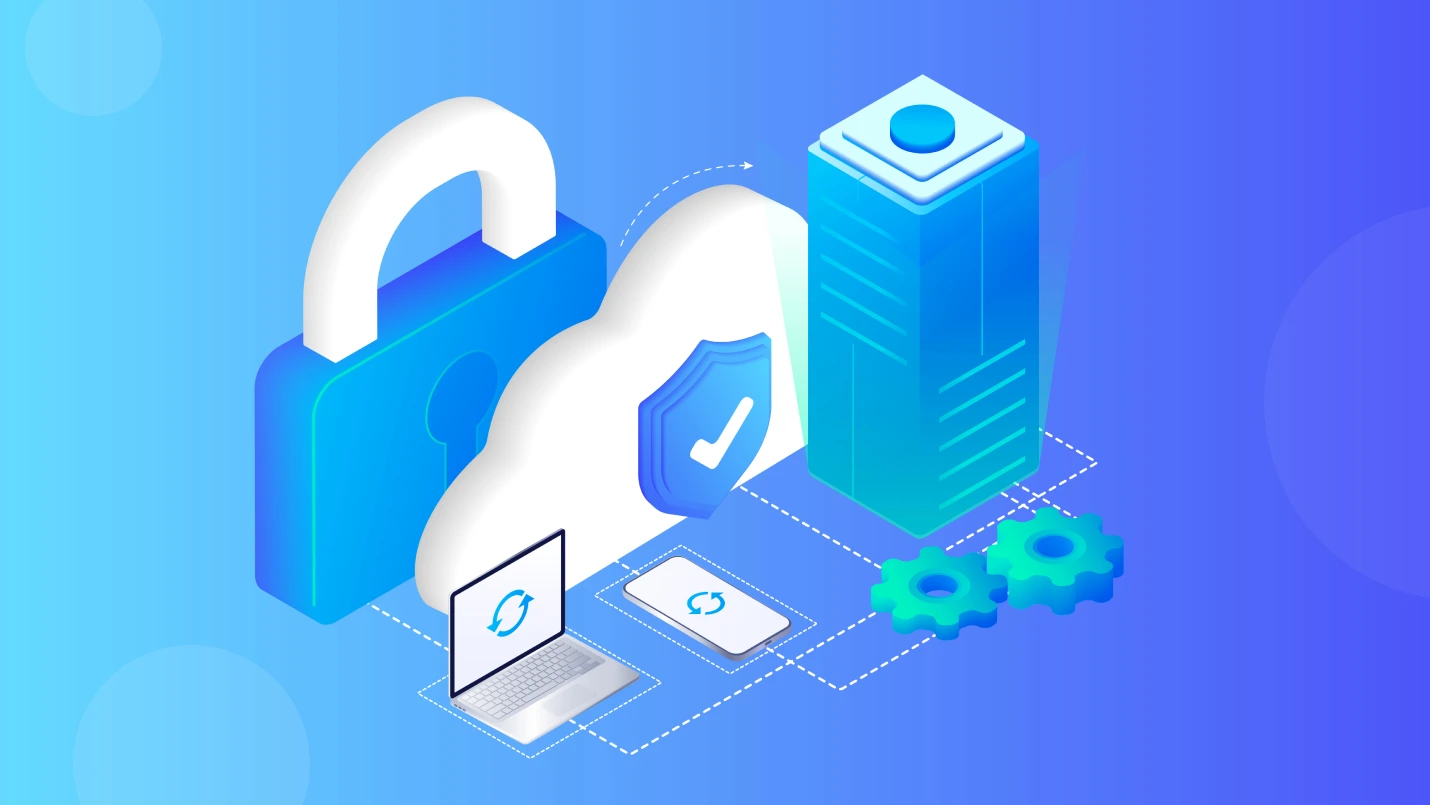Software as a Service (SaaS) is currently a $3 trillion industry, and a recent report from McKinsey suggests the total market cap could surge to $10 trillion by the end of the decade.
With such an impressive growth rate, it’s no surprise that many startups want to enter the SaaS market. Of course, that also means competition is fierce. If you want to be one of those SaaS startups that ultimately thrives, you’ll need to tackle product design, development, and marketing with a clear, informed strategy.
This blog post outlines 10 actionable steps you can take to build and launch a SaaS product, beginning with market research and moving all the way through the product development lifecycle.
What is a SaaS Product?
A SaaS product is a cloud-based software application that users access through either an internet browser or a mobile app. SaaS vendors often make their money through regular monthly or yearly subscriptions, but other revenue models are possible (e.g., advertising, in-app purchases).
What is an example of a SaaS product?
Millions of non-techies with internet connections use SaaS products every day without realizing it. What follows are some popular SaaS products with different revenue models, serving very different markets.

- Zoom: The video chat application we all came to know and love during the pandemic is one of the most popular SaaS applications in the world, offering a free version as well as different types of paid subscriptions.
- HubSpot: HubSpot is a subscription-based CRM with tiered pricing for businesses of different sizes and free marketing tools for basic accounts.
- Google Docs: Google Docs is the MS Word alternative that is now more popular than Word itself. It’s free, like most of Google’s products, but Google does monetize Google Drive through data storage subscriptions. It also keeps users in the Google ecosystem, which supports the Google brand.
- Shopify: Shopify is a SaaS product that makes it easy for small eCommerce entrepreneurs to build, launch, and manage an eCommerce store.
- ChatGPT: ChatGPT is the popular AI application that uses Natural Language Processing (NLP) to answer questions about literally anything and produces eerily human-like conversations.
- Adobe Photoshop: Photoshop is the world’s most popular photo editing software, available for a subscription.
- Slack: Slack is a subscription-based workplace collaboration tool.
This is a quick tour of some popular SaaS products on the market today that have a variety of approaches to monetization. Although they all perform different tasks, they fit the SaaS business model because they’re cloud-based software products.
How to Build a SaaS Product Step-By-Step
New product development is an exciting, dynamic process where you’ll gradually watch your idea come to life.
While software development and design are creative processes, it’s important to note that building a new SaaS product is rarely the work of some lone creative genius. The best SaaS products are collaborative efforts, drawing from market research and addressing user needs, drives, and feedback.

The following 10 steps will give you a bird’s eye view of the design and development process.
Step #1: Conduct market analysis
Market analysis is the process of researching and analyzing the current market, including user needs, the competitive landscape, and opportunities to address gaps in the current offerings.
Comprehensive market analysis will allow you to:
- Spot trends in current SaaS products.
- Identify areas where you can differentiate your product from your competitors’ products.
- Tailor your product to customer needs.
- Identify underserved market segments worth targeting.
Here’s a high-level view of how to conduct market research and analysis:
- Research the industry as a whole: Explore credible, secondary resources to evaluate the current market cap for your category of products, market growth, trends, etc.
- Spot gaps in the market: Explore all the leading competitors out there. Read reviews to determine where the current leaders are falling short.
- Define your market: Find a market segment to serve, evaluate the potential return from that market, and explore your ability to reach them.
- Conduct user research: Surveys, interviews, and focus groups will allow you to better understand your target audience, their needs, and how you can serve them.
- Identify any barriers to entry: Are there legal hurdles you need to cross to enter this market? Does entering the market require funds you don’t currently have? Identify any and all barriers to entry and determine whether they’re surmountable.
- Assess potential profitability: Can you expect to turn a reasonable profit with the product and business model you envision, whether in the short term or the long term?
Step #2: Create a business plan
A business plan is a detailed document that outlines your SaaS company’s goals, how you plan to achieve them, and how you expect to eventually turn a profit.
A business plan will be useful when seeking investors, but that’s not the only benefit. Whether you plan to seek external funding at some point or remain entirely self-funded, a business plan will help clarify your goals, attract quality talent, and clarify your product, marketing, and monetization strategy.
Every business plan should include the following items:
- Unique selling points: What differentiates your product from others on the market?
- Customer pain points: How does your product address and solve a problem? All your research from Step 1 will guide you in identifying customer pain points.
- Target audience: Who are they, and how do you plan to connect with them through your marketing strategy?
- Monetization strategy: How do you plan to make money from your app? See the next step to explore different pricing models.
- Financing plan: How do you plan to finance your app? The initial phase often involves bootstrapping, while later stages may involve seeking venture capital or continuing to fund your growth through profits. You might even consider crowdfunding to get up and running.
- Goals and milestones: Create a roadmap and set up goals for the year ahead, paying special attention to milestones for the first quarter while you’re ramping things up.
This is a rough outline of what you’ll want to include in a business plan. Be sure to explore detailed business plan guidelines and templates when you begin writing.
Step #3: Define your product’s requirements
When we talk about a SaaS product’s requirements, we’re talking about the major technical, legal, financial, and security standards and frameworks needed to build and launch it.
What follows are some common requirements for SaaS products, but know that your product will have its own set of requirements. It’s important to consult experts in each domain (legal, technical, etc.) to identify all your product requirements before writing a single line of code.
-
- Tech requirements: All SaaS products, by definition, are cloud-based, and ideally they should be cloud-native. Any apps you use to support your platform should use MACH architecture (Microservices-based, API-first, Cloud-native, Headless), which is highly flexible and scalable. Also consider security requirements and protocols, ideally adopting a DevSecOps approach to security.
- Legal requirements: SaaS companies may face a whole host of legal requirements depending on the region and industries they serve.
For example, anyone with clients located in the E.U. needs to deal with the data regulation requirements of GDPR, while healthcare companies serving the U.S. need to comply with HIPAA. You’ll also have to explore your terms and conditions, privacy statements, disclaimers, and more, so be sure to speak with a qualified attorney.
- Financial requirements: Identify the capital you need in order to stay afloat before you either become profitable or receive an influx of venture funding. Also, be sure to outline any financial agreements associated with possible exit strategies (buyouts, IPOs, acquisitions, or liquidations).
Step #4: Define your tech stack
The technology stack you use to build your SaaS product is one of the most important choices you’ll make since it will impact your software’s performance and your startup’s potential for rapid scalability.
Your tech stack will have four fundamental pillars: Front-end development, back-end development, a database, and a cloud hosting infrastructure. Here’s a quick guide to each.
- Front-end development: Your front-end development tech stack consists of the programming frameworks you will use to build the Graphic User Interface (GUI)—the part of the program your customers interact with. Some JavaScript frameworks designed for SaaS development include React, Angular, and Vue.js.
- Backend development: Your backend or serverside tech stack handles the technical underpinnings of the app—everything the users don’t see. Ruby on Rails and Node.js are common languages used for back-end SaaS development.
- Database: Your database is the part of your tech stack that stores all the information required to run your applications. Popular databases for SaaS products include PostgreSQL, MySQL, and NoSQL.
- Cloud hosting: Your cloud infrastructure is where your SaaS product lives. Each cloud infrastructure has its own pros and cons. Some popular cloud hosts are Amazon Web Services (AWS), Google Cloud, and Microsoft Azure.
If you’d like some guidance on cloud hosting, we wrote a blog post about choosing the right cloud service provider that can help you make an informed decision.
Step #5: Gather your SaaS development team
When forming a SaaS development team, you have three options.
First, you can hire everyone in-house—a tall order if you’re a bootstrapped startup, but not impossible if you’re well-funded. Second, you can outsource the entire project to a software development company. Third, you can combine the two options, working with some in-house staff or partners while outsourcing certain tasks and roles.
However you approach building your initial team, you’ll want to fill the following roles:
- Business analysts: Business analysts work to understand the market and implement a strategic approach to marketing the product and building the business. They conduct user and market research and communicate what they learn to designers and developers. They may also help build your go-to-market strategy.
- Designers: User Interface (UI) designers create the look and feel of the product. They work side-by-side with User Experience (UX) designers, who help build intuitive, user-friendly workflows into the product.
- Software Engineers: Software engineers take those designs and turn them into a working software product, constantly interfacing with design teams and researchers to deliver something users will love.
- QA Engineers: Quality Assurance engineers test for bugs and security holes prior to each release.
- Project Managers: Project managers oversee everything, coordinate between teams and departments, and keep the entire development lifecycle on track.
It’s important to note that many technical founders are tempted to do all the coding themselves, but this can distract them from thinking about big-picture strategy. That’s why many founders with tech backgrounds hire us to design and build their products.
Step #6: Design the product
Product design should always be informed by user research—not just in the beginning when identifying a problem to solve, but throughout the entire design process.
UI and UX designers typically begin the design process with low-fidelity prototypes, which are simple mockups of what end users would see on a screen if they were using the final SaaS platform or product.
UX researchers gather users who fit the target demographic and walk them through the product’s workflow, asking them which button they would tap or which path they would follow to accomplish a given task. This helps them evaluate the current design and suggest revisions based on what their research reveals.
Designers then modify the design further, often using high-fidelity wireframes at later stages to create something that closely resembles an actual app. The process eventually gives birth to a high-quality, usable interface, which developers then build.
Of course, the process doesn’t end there. Design and development are iterative processes, with everyone working together to build a solid software product.
Step #7: Build your MVP
A Minimum Viable Product (MVP) is a software product that performs the main, intended function it was designed to perform, without including the wide array of features that a more mature product would have. As the name implies, it’s minimally viable, not fully optimized.
Building an MVP is a cost-effective way to validate a product idea without spending an inordinate amount of money on features that the market may not actually want or need.
Most custom software development begins with an MVP. Based on feedback from the initial group of users, the designers and developers begin adding features that customers truly want.
The MVP process reduces initial labor requirements and software development costs , allowing companies to focus their resources on implementing data-driven improvements down the line that customers will love.
Step #8: Begin beta testing
Beta testing involves testing SaaS software with real users—before releasing it to the market. Beta tests can be open or closed, but in either case, they’re meant to uncover bugs and usability issues before the official release.
Beta testers will also assess the functionality of the product. Based on their feedback, designers and developers can make additional changes before the launch.
Step #9: Pick your pricing model
There are a number of ways to monetize SaaS products. Here are some of the most popular pricing models.
- Freemium: The app is free to download and use, but more advanced features require purchasing through a monthly subscription or in-app purchases.
- Advertising: Some apps make money through advertising within the app, with most offering an option to purchase an ad-free subscription.
- Subscription: Most SaaS products use a monthly and yearly subscription model, offering discounts for annual or multi-year signups.
- Other models: Although the three models listed above are the most popular, there are other pricing models for SaaS products, such as a transactional model that charges based on usage. Another example would be a retail model, where retail stores put our free SaaS apps that guide users to purchase their products.
Step #10: Launch your SaaS product
Now it’s time to launch your SaaS product, but that doesn’t mean you can simply relax and enjoy the fruits of your labor. In fact, much of the interesting design and development work will be done after your launch—once you start getting feedback from real users on your MVP.
These users will guide your design and development efforts with each release, and you’ll need to weigh the feedback you receive based on the value it provides, the costs and risks you’ll incur, and other factors.
Again, SaaS product development is a continual process. Each new release will incorporate customer feedback, and the choices you make will be informed by competitor features and the changing market landscape.
Which Metrics Should You Track after You Launch Your SaaS Product?
SaaS companies track a number of metrics to evaluate their product’s performance over time and assess the health of their company.
The first four metrics on this list are absolutely vital to track. The final two (Net Promoter Score and CSAT) are excellent metrics to understand what customers think of your brand and your products, but there are other metrics that can assess public perception as well.
- Monthly Revenue: How much are you earning each month in sales? Are sales improving?
- Customer Acquisition Costs (CAC): How much money do you have to spend, on average, to acquire a new customer?
- Customer Lifetime Value (CLTV): How much revenue does the average customer generate over their lifetime as your customer?
- Churn: How many customers do you lose each month? And how does this compare to the new customers you acquire over the same timeframe?
- Customer Satisfaction (CSAT): How satisfied are your customers with your product?
- Net Promoter Score (NPS): NPS surveys ask customers how likely they are to recommend your product to a friend or colleague. Your NPS, relative to others in your industry, will tell you a great deal about your brand’s appeal.
Taking a data-driven approach to running your SaaS company is important because the numbers give you an objective measure of what you’re doing right and any problems you need to address.
Looking for an Outsourcing Company with Years of SaaS experience?
Net Solutions has developed countless products for SaaS businesses over our 20+ year history, working with innovative startups like Soaq as well as established organizations like American Golf and the Harvard Business Review.
If you’re looking for guidance, staff augmentation, or end-to-end design, development, and project management to develop your SaaS product, schedule a free consultation to see what Net Solutions can do for you.
Frequently Asked Questions
SaaS solutions offer advantages over on-premise software for both the software companies that sell the apps as well as their customers. These advantages include:
- Quick launch (for companies) thanks to the flexibility of cloud computing
- Steady revenue for those that adopt a subscription model
- Regular updates that help customers enjoy the latest, most secure versions of SaaS apps
- Flexibility for everyone involved in terms of pricing, options, etc.
SaaS app development is popular across many different industries and revenue models. Here are some of the many different types of SaaS products and companies that exist.
- eCommerce software like Shopify, which supports retail entrepreneurs in numerous ways
- Client Relationship Management (CRM) software like Salesforce, which helps businesses manage customer relationships, marketing outreach, sales notes, etc.
- Enterprise Resource Planning (ERP) software like Oracle Cloud Enterprise, which enables companies to track and manage business operations
- Project management software like Jira, which keeps programmers on track
- Billing software like Freshbooks, which helps small businesses balance their books
These are just a few use cases for SaaS technology.
Building a SaaS product is no easy task. The following are some common challenges that startups face when designing, developing, launching, and managing a new SaaS product.
- Finding the right product-market fit that serves a lucrative niche
- Following all regulations and industry standards regarding security and data privacy
- Acquiring new customers at a reasonable cost
- Retaining customers (also known as limiting churn)
- Scaling your team at the right pace, at ideal intervals, so you stay ahead of your burn rate while taking care of business
Again, don’t hesitate to consult an experienced outsourcing partner for guidance if you’re concerned about any of these challenges. We’ve built many SaaS products over the years here at Net Solutions, and we know how to handle these sorts of roadblocks.




